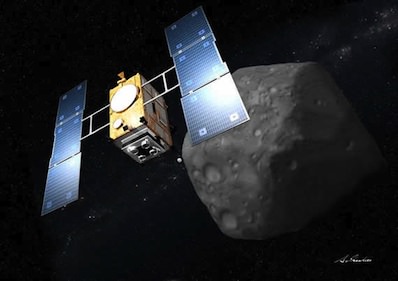[/caption]
In 2010, the Japanese spacecraft Hayabusa completed an exciting although nail-biting mission to the asteroid Itokawa, successfully returning samples to Earth after first reaching the asteroid in 2005; the mission almost failed, with the spacecraft plagued by technical problems. The canister containing the microscopic rock samples made a soft landing in Australia, the first time that samples from an asteroid had been brought back to Earth for study.
Now, the Japanese government has approved a follow-up mission, Hayabusa 2. This time the probe is scheduled to be launched in 2014 and rendezvous with the asteroid known as 1999 JU3 in mid-2018. Samples would again be taken and returned to Earth in late 2020.
1999 JU3 is approximately 914 metres (3,000 feet) in diameter, a little larger than Itokawa, and is roughly spherical in shape, whereas Itokawa was much more oblong.
As is common for any space agency, the Japanese Aerospace Exploration Agency (JAXA) is working with tight budgets and deadlines to make this next mission happen. There is a possibility of a back-up launch window in 2015, but if that deadline is also not met, the mission will have to wait another decade to launch.

One of the main problems with Hayabusa was the failure of the sampling mechanism during the “landing” (actually more of a brief contact with the surface with the sample capturing device) to retrieve the samples for delivery back to Earth. Only a small amount of material made it into the sample capsule, but which was fortunate and ultimately made the mission a limited success. The microscopic grains were confirmed to have primarily come from Itokawa itself and are still being studied today.
To avoid a repetition of the glitches experienced by Hayabusa, some fundamental changes needed to be made.
This next spacecraft will use an updated ion propulsion engine, the same propulsion system used by Hayabusa, as well as improved guidance and navigation systems, new antennas and a new altitude control system.
For Hayabusa 2’s sample-collecting activities, a slowly descending impactor will be used, detonating upon contact with the surface, instead of the high-speed projectile used by Hayabusa. Perhaps not quite as dramatic, but hopefully more likely to succeed. Like its predecessor, the main objective of the mission is to collect as much surface material as possible for delivery back home.
Hopefully Hayabusa 2 will not be hampered by the same problems as Hayabusa; if JAXA can achieve this, it will be exciting to have samples returned from a second asteroid as well, which can only help to further our understanding of the history and formation of the solar system, and by extrapolation, even other solar systems as well.


I think we should chase down a comet. A one way trip, and maybe even a lander to hitch a ride!
John Ross: the mission you are interested is Rosetta. It launched years ago but doesn’t arrive at the comet until 2014. It does have a substantial lander that is supposed to operate for a month.
One comment:
I don’t know if this was a typo, but MINERVA was not equipped to collect samples.
Just a typo, sorry, I’ve fixed that. I’ve been trying to write all day with crappy back pain, oh well. 😉
Do you mean attitude here? Or is this the system for controlling altitude above the asteroid’s surface?
Ouch! Get well!
Yay! Besides the great scientific returns of H-1, the new mission is an enduring receipt of the “can make it” attitude of JAXA.
Hopefully NASA can learn some. (Not that they didn’t start it with Apollo-13, of course.)